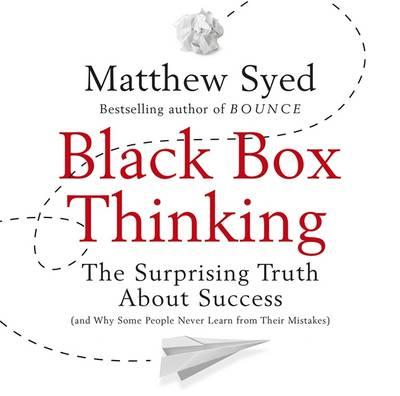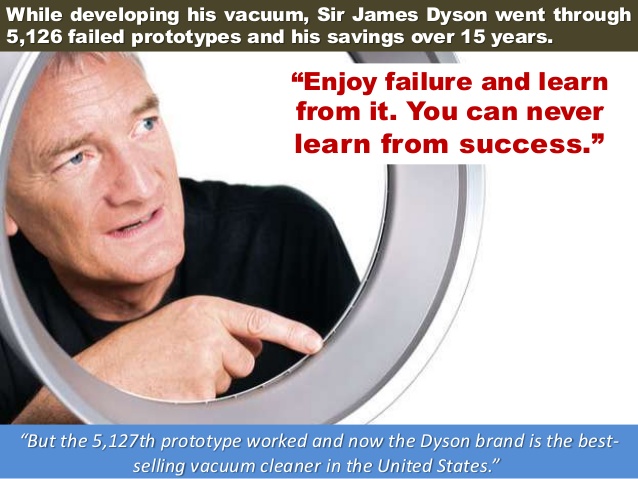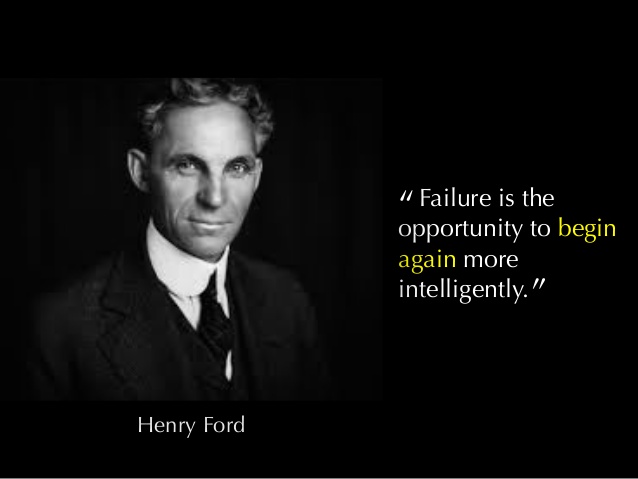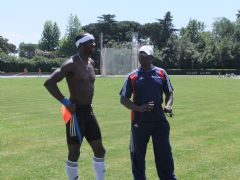In my previous blog, I had started to review Matthew Syed's latest book, "Black Box Thinking". I had looked at the concepts of "Growth Mindset vs Fixed Mindset" cultures and "Cognitive Dissonance", considering how these behaviours affect our ability to learn from error and failure. In this post, I will continue to look at the other three key points I learnt from the book.

Getting Started vs Launching with Perfection
Syed argues that the desire for perfection rests upon two fallicies.
“The first resides in the miscalculation that you can create the optimal solution in a bedroom or ivory tower and thinking things through rather than getting out into the real world and testing assumptions, thus finding their flaws. It is the problem of valuing top-down over bottom-up.
The second fallicy is the fear of failure…You spend so much time designing and strategising that you don’t get a chance to fail at all, at least until it is too late. It is pre-closed loop behaviour. You are so worried about messing up that you never even get on the field of play.”
Black Box Thinking discusses the evolutionary approach to learning, which is an adaptive process underpinned by the detection of and response to failure. By getting started on solving a problem and testing iterative attempts repeatedly will achieve results far quicker than trying to solve the problem in theory for hours or days on end.
In industries, such as the software industry, where the rate of product turnover and innovation is so fast, designers have discovered that the way to achieve greatest success is to get an embryonic form of a concept out on to the market, then use feedback from customers to continually adapt and evolve a product that finally does what is required. This way, the developers can respond to market demand and even change the end goal from what they initially anticipated according to a new path as directed by the consumer.
Syed narrates an experiment documented in Bayles and Orland’s book, “Art and Fear”, where students in a ceramics class were divided in two groups by their teacher. The first group was told that they would be graded on quantity, with the teacher awarding an ‘A’ for 50lbs of pots, a ‘B’ for 40lbs of pots etc submitted on the last day of term. Meanwhile, the second group were told that they just had to present one pot for grading, their “perfect pot”. The authors reported empathic results, whereby the best quality work was all produced by the group being graded for quantity, with students producing high volumes of work but learning from their mistakes each time, whilst the second group had simply tried to theorise what the perfect pot should look like. In failing more, the first group of students were able to learn more.
To achieve success through this method, you have to have a resilient mindset and be open to confronting failure and leveraging its power. Becoming attached to a cherished idea is problematic because if you align yourself too strongly with the idea, you’ll fail to acknowledge the lessons that testing throws up and you will struggle to take on board and learn from the errors that move you forward.
Syed further illustrates this approach to learning with the story of how Unilever solved a technical conundrum that was blighting their washing powder line. The nozzle that was used to fill boxes of laundry detergent kept blocking time and again. In order to find a solution, the board turned to their mathematicians, who they used to address their technical problems and as per routine, they studied the nozzle design, collaborating at regular intervals in seminars and team meetings.
Frustratingly, the proposed solution failed and in desperation, the company turned the problem over to its team of biologists, who despite knowing little of fluid dynamics, did have a grasp on the relationship between failure and success in the process of evolution. The biologists took ten copies of the nozzle and applied small changes to their dimensions before subjecting them to a battery of failure tests. At the conclusion of each test battery, the team took the ‘winning’ nozzle and created ten more nozzles with yet further subtle revisions and repeated the process again and again. 45 generations and 449 ‘failures’ later, the biologists had developed a nozzle that worked ‘many times better than the original’.
Marginal Gains
I’ve written about the aggregation of marginal gains in improving performance before. British Cycling and their professional off shoot, Team Sky, coined the term but the concept has been around for many years and in the Japanese business culture, they refer to the philosophy as ‘kaizen’.
The idea is that instead of trying to bring about perfection in one giant leap, you focus on the small steps of progression in many areas and compound the improvement. By paying attention to detail in each aspect of the business or project you are working on, and asking each person involved to see how they can bring about a 1% positive change in their contribution, the overall result will be a substantial enhancement of performance.
Breaking down a big goal in to small parts, makes drastic improvement seem more achievable, makes everyone accountable for the task they are asked to contribute and develops a sense of worthiness to the overall project. However, the concept doesn’t work just by making small changes and hoping they work, rather it is about breaking a big problem down into smaller parts in order to rigorously establish what works and what doesn’t. The approach makes it easier to test, fail and learn in different aspects of performance whilst being able to evaluate which component made a difference and gaining a deeper understanding of each facet of performance.
Syed quotes Sir David Brailsford, the Performance Director of Team Sky and former Performance Director of British Cycling, who says “I realised early on that having a grand strategy was futile on its own. You also have to look at a smaller level, figure out what is working and what isn’t. Each step may be small but the aggregation may be huge”.
Another team renowned for adopting this approach to performance is the Mercedes Formula 1 team. One of my former colleagues at McLaren Racing, Paddy Lowe, is the technical leader at the team and explained to Syed how the accumulation and analysis of vast amounts of data, derived from every single parameter of the car’s performance provides important information on a small aspect of performance, thus enabling the team to isolate key metrics that guide improvement. The developments in performance can’t just be brought about by looking at the outcomes, however, and Lowe highlights that it’s just as important to improve your data sets and strategy to ensure that there is a greater understanding of what you didn’t initially understand. When Lowe first arrived at Mercedes, the team recorded eight channels of data, now they aggregate 16,000 from each component of the car and another 50,000 channels from that data.
As Syed states after meeting these teams, this approach to learning underlines the principle that “every error, every flaw, every failure, however small, is a marginal gain in disguise. This information is regarded not as a threat but as an opportunity”.
This approach isn’t limited to sport. Google, Capital One and even charity operations in Africa have adopted the approach of testing their assumptions and conducting thousands of randomised controlled trials on various aspects of their business in order to improve their efficacy. This intellectual honesty and openness to learn from failure is relevant to any business or problem that presents itself and history is littered with the names of high profile companies that ignored the need to learn from failure and paid a substantial price. Think Blockbuster, who were superseded by companies such as Netflix, think Kodak who were dealt a hammer blow by the digital revolution they helped invent and think Xerox.
Inventors often operate along similar lines when it comes to coming up with innovative solutions to long standing problems. Syed cites the example of James Dyson, the chairman and chief designer of the company that reinvented the vacuum cleaner and the hand drier. Dyson didn't just bump his head in the shower one day and come up with the answer to problems that plagued routine household chores for decades. Syed quotes a statement that Dyson made in their conversation in that “The original idea is only 2 per cent of the journey. You mustn’t neglect the rest”.
In creating the revolutionary vacuum cleaners, Dyson identified a problem, researched it, connected solutions that were effective in similar tasks in remote industries and connected the ideas. He then proceeded to make prototype after prototype, testing each, learning from the failure of each test, applying the lessons to the next iterations and step by step arrived at a model that performed the task he was seeking. Dyson states that his aim is to be wrong as fast as he can, accepting that he is going to fail and as a result, the lessons are learned quickly and the feedback integrated into the development as soon as possible. He continues, “I won’t get it right first time but I will get it wrong really soon, really quickly”.

Redefining Failure
Obviously not everybody views failure in the same way and it often appears that successful people view failure as an indispensable part of the overall process of improvement and subsequently embrace, rather than shy away from it.
Matthew Syed illustrates this point with the example of David Beckham, who gradually improved his footballing skills through hours and hours of practice in his back garden. Whilst from the outside, the public see the great successes of game winning free kicks, those closest to him recall the thousands of practice strikes he hit with his father in the local park and the extra hours put in at the training grounds once other players had gone home, that contributed to the development of his impressive repertoire. Nike famously exploited a similar philosophy voiced by Michael Jordan for one of their commercials.
Science has shown that individuals learn faster when they display a bigger neurological reaction to a mistake and then pay more attention to the nature of the error and it is this response pattern that is displayed by those with a growth mindset. These people engage with their errors and use the feedback to guide their progression.
The question that then comes to mind, is how, armed with this knowledge, can we create a growth mindset in those whom we coach or lead. For this answer, Syed returns to a study conducted by the psychologist, Carol Dweck, which he first referred to in his first book, “Bounce”. After giving two groups of ability-matched children eight easy tests and then four very challenging ones, Dweck observed that those with a fixed mindset blamed their lack of intelligence for their failure to answer the difficult questions, whilst the children with a growth mindset didn’t even consider that they were failing. Instead, the latter group improved their strategies as they taught themselves different ways to tackle the problems that were supposedly beyond their level of ability. To the children demonstrating the growth mindset, intelligence was perceived as being dynamic and something they were able to grow, expand and improve. The problems were considered learning opportunities and welcome challenges against which they could pit their abilities.
By constantly reinforcing to children that good results are a result of their hard work and their progress has come about due to the efforts they have contributed, develops an understanding that they are in control of their improvement. Thus these children work to find ways to succeed at the tasks with which they are confronted, even if at first the answers are not apparent. On the other hand, by rewarding positive achievements with feedback such as “you are so intelligent”, suggests to children that their ability is an innate quality and one that will have a direct and fixed relationship with the results they achieve. As a result, when these children start to struggle when faced with difficult tasks, they give up, believing that they aren’t smart enough to solve the problem.
More pertinently for those of us that try to establish growth mindset cultures, Dweck also recognised that organisations demonstrate either growth mindset or fixed mindset characteristics. Companies displaying growth mindset traits were found to have cultures that were more honest, collaborative and demonstrated a robust attitude to error. In contrast, employees working in fixed mindset companies worried about mistakes, feared blame and reprisal, which resulted in a tendency to conceal errors.
Building on this concept, Syed states, “If we only ever praise each other for getting things right, for perfection, for flawlessness, we will insinuate, if only unintentionally, that it is possible to succeed without failing, to climb without falling. In a world that is complex, whose beauty is revealed in its intricacy and depth, this is misconceived. We have to challenge this misconception, in our lives and in our organisations”. In my opinion, that is a really powerful concept that I will take forward in my interaction with colleagues.
It is this mindset that is apparent in entrepreneurs. The most successful entrepreneurs in our cultures have tried and failed spectacularly but learnt the lessons from their experiences and harnessed them to inform subsequent projects. Just think of Henry Ford, Richard Branson, Steve Jobs or Simon Cowell, each of whom displayed incredible resilience and a capacity to face up to failure and learn from it.

The Pre-Mortem
The key to creating a culture that engages in the power of learning from mistakes, in our workplace or in our personal lives, depends upon our ability to change the notion of failure being embarrassing to one that perceives it as educative and necessary for growth. To do this, we need to create systems that harness the power of adaptivity and ensure we have access to the evidence that shows objectively where our judgement might be wrong, which in turn will improve our decision-making. Obtaining meaningful feedback is critical to the process.
Employing pilot studies designed to test, rather confirm assumptions, is one way to achieve this process but conditions must be representative of normal situations, rather than conducting the pilot study in a bubble environment that can never be replicated in real life execution.
An idea that Syed explains, and one that caught my imagination, is the “pre-mortem”, whereby a team is asked to consider why a proposed plan has gone wrong, even before it has been put into operation. Instead of considering what might go wrong, the group employ prospective hindsight, being told that the project concerned has already failed and to write down the reasons why they believe that was the case on a piece of paper, before sharing them in turn with the group. By making failure concrete, rather than abstract, people are encouraged to disclose their concerns, rather than keep them private. Studies have shown this approach enhances an individual’s ability to correctly identify reasons for future outcomes by 30% and so instead of being used to abort plans, it is used to strengthen them.
The fact that this is a relatively easy exercise to engage in and doesn’t cost anything other than time, means that this is a really useful tool that I will look to employ when planning future projects.
Conclusion
“Black Box Thinking” is another fascinating offering by Matthew Syed that has forced me to look at aspects of my learning very differently. Whilst I always considered myself to have a growth mindset, the book has made me explore my perceptions of failure in great depth and has definitely changed how I would look to incorporate some of these concepts into developing a culture that displays a growth mindset. I have always had a tendency to try and achieve perfection before launching a project but from now on, I will take the plunge much earlier, purposefully being more observant and proactive in testing the responses to exposure in order to inform continued progress.

